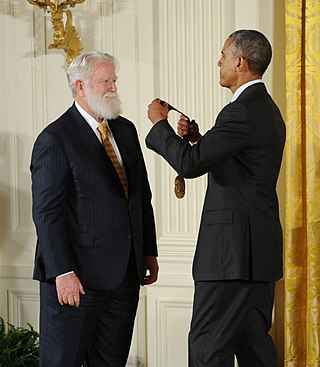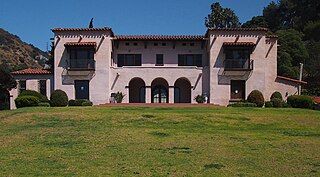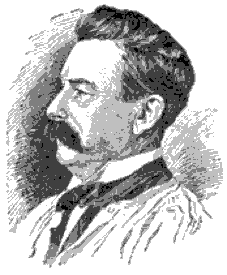
Frank Owen Gehry is a Canadian-born American architect and designer. A number of his buildings, including his private residence in Santa Monica, California, have become world-renowned attractions.
The Huntington Library, Art Museum and Botanical Gardens, known as The Huntington, is a collections-based educational and research institution established by Henry E. Huntington and Arabella Huntington in San Marino, California. In addition to the library, the institution houses an extensive art collection with a focus on 18th and 19th century European art and 17th to mid-20th century American art. The property also has approximately 120 acres (49 ha) of specialized botanical landscaped gardens, including the "Japanese Garden", the "Desert Garden", and the "Chinese Garden".

Robert Walter Irwin was an American installation artist who explored perception and the conditional in art, often through site-specific, architectural interventions that alter the physical, sensory and temporal experience of space.

Descanso Gardens is a 150-acre (61 ha) botanical garden located in La Cañada Flintridge, Los Angeles County, California. It sits on the northern edge of the San Rafael Hills.

James Turrell is an American artist known for his work within the Light and Space movement. He is considered the "master of light" often creating art installations that mix natural light with artificial color through openings in ceilings thereby transforming internal spaces by ever shifting and changing color.
Diller Scofidio + Renfro is an American interdisciplinary design studio that integrates architecture, the visual arts, and the performing arts. Based in New York City, Diller Scofidio + Renfro is led by four partners – Elizabeth Diller, Ricardo Scofidio, Charles Renfro, and Benjamin Gilmartin – who work with a staff of architects, artists, designers, and researchers.

Jun Kaneko is a Japanese-born American ceramic artist known for creating large scale ceramic sculpture. Based out of a studio warehouse in Omaha, Nebraska, Kaneko primarily works in clay to explore the effects of repeated abstract surface motifs by using ceramic glaze.
Gregory Samuel Ain was an American architect active in the mid-20th century. Working primarily in the Los Angeles area, Ain is best known for bringing elements of modern architecture to lower- and medium-cost housing. He addressed "the common architectural problems of common people".

Doug Aitken is an American multidisciplinary artist. Aitken's body of work ranges from photography, print media, sculpture, and architectural interventions, to narrative films, sound, single and multi-channel video works, installations, and live performance. He currently lives in Venice, California, and New York City.

Standish Backus, Jr. was a United States military artist.

William Frederic Ritschel, also known as Wilhelm Frederick Ritschel, was a California impressionist painter who was born in Nurenberg, Kingdom of Bavaria.
Diana Thater is an American artist, curator, writer, and educator. She has been a pioneering creator of film, video, and installation art since the early 1990s. She lives and works in Los Angeles, California.

The Wattles Mansion, formally known as Jualita, is a former estate in the Hollywood area of Los Angeles, California. The mansion is a Mission Revival style mansion built in the estate in 1907 for wealthy Omaha banker Gurdon Wattles as his winter home; the estate contains a complex of gardens. It was sold to the city in 1968 and became the Wattles Garden Park, operated by the Department of Recreation and Parks. The mansion and gardens were designated a Los Angeles Historic-Cultural Monument in 1993.

The Harold Lloyd Estate, also known as Greenacres, is a large mansion and landscaped estate located in the Benedict Canyon section of Beverly Hills, California. Built in the late 1920s by silent film star Harold Lloyd, it remained Lloyd's home until his death in 1971.
Frederick M. Nicholas is an American lawyer specializing in real estate development and leases. He is known as "Mr. Downtown Culture" for his role in building the Museum of Contemporary Art, Los Angeles, the Geffen Contemporary, the Walt Disney Concert Hall, and for the founding of Public Counsel, the nation's largest public interest law firm. Frederick M. Nicholas has combined his legal career with a heavy real estate involvement to become an institution builder in the arts in Los Angeles.
Fleur de Lys is an extraordinary estate in Holmby Hills, Los Angeles, California.

Eli Harvey was an American sculptor, painter and animalier.
Jorge Pardo is a Cuban-American artist and sculptor. Pardo's artwork explores the intersection of contemporary painting, design, sculpture, and architecture. In 2010, he was awarded a MacArthur Fellowship.
Johnnie Jungleguts is an American artist living in Los Angeles. Jungleguts work spans a range of disciplines and media including drawings, radio, and video and frequently involves video games, comics, and other elements of pop culture.











